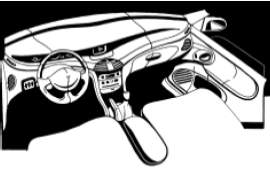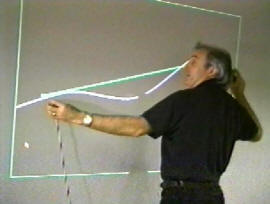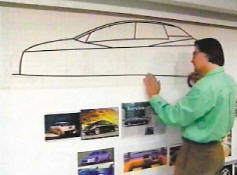|
|
 Tape drawing of a car interior using traditional physical tape drawing techniques. This is an extreme example of tape art, illustrating the artist’s skill in the medium. Picture courtesy of Renault Automotive Corp., France. |
 Digital tape drawing - a new two-handed technique that builds upon existing skills and enables the artist to continue to work on large-format drawing on the wall. |
Size matters. At least when you are drawing. Imagine how differently you would draw if the surface was the size of a postage stamp versus a big whiteboard. It also matters in how we see things. Just imagine watching Lord of the Rings on a cell phone screen compared to a wide screen in a large cinema.
With this in mind, imagine how the designer of your car got the lines so that they looked just right when viewed full size. I never thought about such things until I visited my first automotive design studio. What surprised me was that much of the drawing was done using a technique that I had never even thought of, and which used no electronics at all. It was called tape drawing. In it, the designer draws by stretching out black tape that looks remarkably like what I have always used to tape my hockey stick. They reel it out with their right hand, and stick it against the wall with their left one (even the left handed ones). What was remarkable were the beautiful, smooth, controlled, and well defined lines that they were able to create - lines which became a life-size rendering of the vehicle.
On thinking about it, it occurred to me that I couldn’t imagine a different, or better way to get such curves and control freehand, without using mechanical guides. The technique was as effective as it was unexpected. And the designers were really really good at it. Because it was so effective, and they were so good at it, the designers had no interest in changing techniques. Nothing that they had seen on a computer interested them and they certainly had no interest in working on a surface as small as your typical computer screen. The reason that we were involved was that the tape drawings somehow had to get into a computer for the rest of the design process. How could we improve the laborious process of digitizing them, without forcing an unwelcome change on these talented artists?
My view was that if the tape artists were not going to go to the computer, we would take the computer to them. The challenge was to do so in a way that both showed respect for and took advantage of all of the remarkable skills that they had cultivated over the years.
So, what we did was design a system where the designers worked on a rear-projection surface which was the same size as what they were used to. Then we developed two small controllers, one for each hand, such that when they came up to the electronic wall, they had “electronic” tape that they could stretch and “stick” using both hands, in essentially the same manner as they did with the traditional process.
So, how did we know if we succeeded? Well, there are two ways. First, designers who had never used a computer before were able to walk up and comfortably use the system with only about 2-3 minutes of practice/instruction. Second (which if I am honest, really frustrated me), they immediately started doing drawings that made drawings that made mine and those of my team look like exactly what they were: the work of novices. That is, the quality of the result was a function of one’s skill as a designer and ability to tape draw, not one's ability to use a computer. Humbling for us computer geeks, but exactly the way it should be.
For more information see (Note the videos):
-
Balakrishnan, R., Fitzmaurice, G., Kurtenbach, G., & Buxton, W. (1999). Digital tape drawing. Proceedings of the ACM Symposium on User Interface Software and Technology (UIST'99), 161-169. [video]
-
Buxton, W., Fitzmaurice, G. Balakrishnan, R. & Kurtenbach, G. (2000). Large Displays in Automotive Design. IEEE Computer Graphics and Applications, 20(4), 68-75.
-
Grossman, T., Balakrishnan, R., Kurtenbach, G., Fitzmaurice, G, Khan, A. & Buxton, W. (2002). Creating Principal 3D Curves with Digital Tape Drawing. Proceedings of the 2002 ACM Conference on Human Factors in Computing Systems, CHI'02, 121-128.
-
Grossman, T., Balakrishnan, R., Kurtenbach, G., Fitzmaurice, G, Khan, A. & Buxton, W. (2001). Interaction techniques for 3D modeling on large displays. Proceedings of the 2001ACM Symposium on Interactive 3D Graphics, 17-23. [video]
